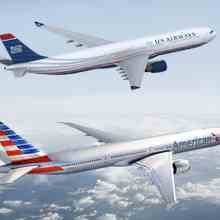Travel News
11 Things You Didn’t Know About the World’s Largest Airline
 The American Airlines merger with US Airways was finalized this morning, creating the world’s largest airline. Prior to the merger, American was the third largest airline and US Airways was the fifth. Additionally, American has emerged from bankruptcy protection in this long-awaited $18 billion deal with US Airways.
The American Airlines merger with US Airways was finalized this morning, creating the world’s largest airline. Prior to the merger, American was the third largest airline and US Airways was the fifth. Additionally, American has emerged from bankruptcy protection in this long-awaited $18 billion deal with US Airways.
Here is what travelers can expect from the world’s largest airline in 2014:
- A Gradual Transition: For the foreseeable future, the airlines will operate separately and system-wide changes will roll out gradually. It’s expected to take 18-24 months for the merger to be completed.
- Expanded Service: The airline will offer 6,700 daily flights that cover more than 330 destinations in more than 50 countries.
- Limited Choices for U.S. Travelers: Following the American Airlines merger, four airlines will now control more than 80 percent of U.S. flights.
- The New American Hubs: Though the airline had to give up high-competition slots in New York LaGuardia and Washington Reagan, it will still have a substantial footprint. The airline will have hubs in Los Angeles, Miami, Chicago’s O’Hare, Philadelphia, Phoenix, Charlotte and New York’s Kennedy International for the next three years at current service levels.
- How Mileage & Loyalty Programs Will Change: The airline has yet to announce its complete plans for frequent flyer programs. Combination efforts are underway. By the first month of 2014, travelers can earn/redeem miles reciprocally for with American Airlines or US Airways program. Flyers will keep their existing miles in their respective accounts.
- A New Alliance: As the merger is structured, US Airways will no longer be in the Star Alliance as of March 30, 2014. Instead, it will join American and the airlines in the oneworld alliance whose partners include British Airways, Cathay Pacific, Japan Airlines and Qatar Airways.
- Unions Support Merger: The merged airline currently employs more than 100,000 workers and that’s anticipated to change. Currently, the merged airline has the support of the Association of Professional Flight Attendants for American Airlines. It doesn’t not have the support of mechanics and machinists for US Airways, represented by the International Association of Machinists and Aerospace Workers, who have held out support until its contract is finalized.
- Technological Foresight: Following the technology bumps that preceded the United/Continental merger, CEO Doug Parker has hopes of a smoother transition. Initially, the airlines will operate with separate websites and separate reservations systems. Eventually, the merged airline will be using the reservation system at AMR’s American, the bigger airline.
- The Most Valued Travelers: CEO Parker has set a goal for $1 billion in new revenue and savings. Business travelers are a big part of this new plan. With the merged airline, the airline will reach more destinations and will have, “more ability to compete for corporate customers” according to American executive Scott Kirby.
- A Stock to Watch? One Bloomberg News report had analysts estimating that the AAL stock will be worth close to $40 a share by 2015. Today the stock rose more than 4 percent to trade at $25.18 a share as of 3:30 pm.
- Rising Airfares? While the common rule of mergers is diminished capacity, CEO Parker swears that is not his intention. According to his statement to the press: “We’re keeping all the airplanes, keeping all the people,” he said of the merger. “So supply should be unchanged. As long as demand stays the same, nothing should happen to prices.”
For a walk through the merger history, check out:












